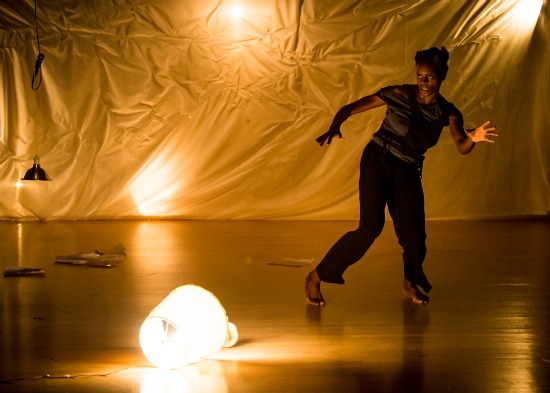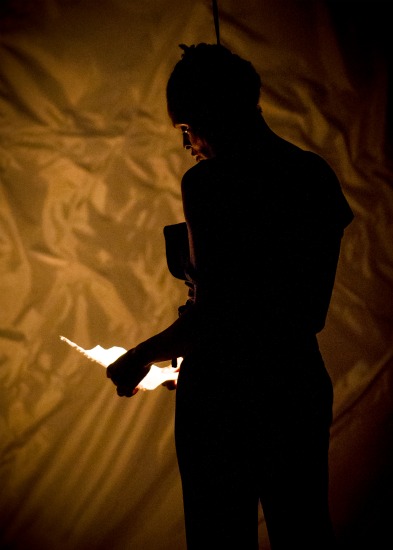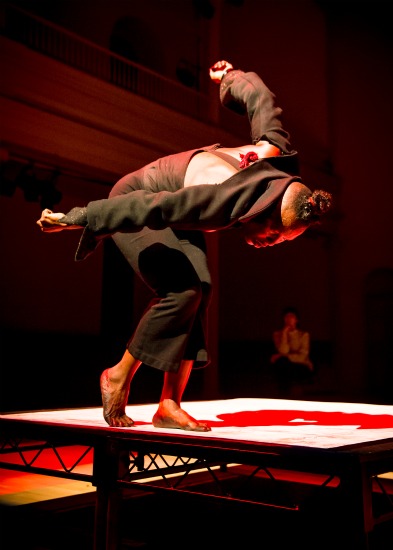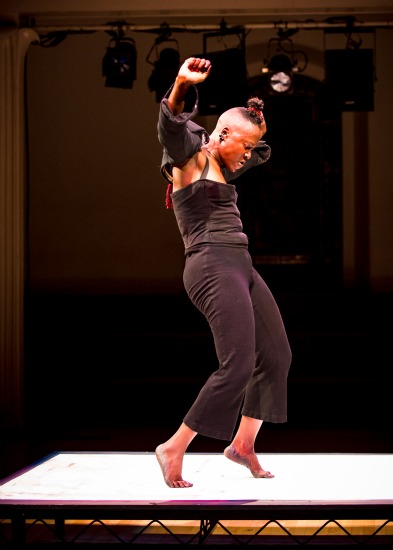In 1982, Ishmael Houston-Jones asked himself some questions about Black Dance (a term embraced at the time by those who considered themselves part of it) and how that aesthetic related to the work that he and some of his African American colleagues on the downtown New York scene were interested in creating. The result: two weekends of performances produced that year by Danspace Project at Saint Mark’s Church, under the title Parallels. On those programs, Houston-Jones was joined by Blondell Cummings, Fred Holland, Rrata Christine Jones, Ralph Lemon, Bebe Miller, Harry Sheppard (now deceased), and Gus Solomons jr. Five years later, Jawole Willa Jo Zollar joined the group for a gig in Paris. With that series, writes Houston-Jones in his preface to the catalogue for PLATFORM 2012: Parallels, “ I was making the case that to be a contemporary Black dance maker, one did not have to be a direct descendant of Ailey.”
Since early February, the 2012 Parallels curated by Houston-Jones has been bringing together today’s equivalent of those postmodernists who gathered 30 years ago and setting up performances and discussions at Danspace and other venues. The penultimate events in the series take place on March 27; on March 31, the church hosts An All Day Event: The End (framework conceived by Lemon).
When Houston-Jones introduced the March 15th Danspace program shared by Nora Chipaumire and Okwui Okpokwasili, he remarked that one difference between the 1982 and the 2012 Parallels was that all the earlier participants were African Americans, while this one included choreographers from Africa or one generation removed from there. On an earlier shared evening by Dean Moss and Reggie Wilson that I very much regret missing, Wilson’s Solo’s Solo/”Basic II” – a study on how NOT to go so low or too deep (with changes in direction) involved a collaboration with Souleymane Badolo from Burkina Faso. Chipaumire was born and raised in Zimbabwe, and Okpokwasili is the American-born child of parents from Southeast Nigeria.
Okpokwasili, a Bessie Award winner for her work in Lemon’s Come Home Charley Patton and an actress of consequence, wrote and performed the solo Bronx Gothic. Peter Born provided direction and décor and collaborated with Carol Mullins on the lighting. The piece is indeed Gothic in terms of darkness and hovering violence, but hardly like some updated Ann Radcliffe novel. Still, although no supposed supernatural forces are at work, the piece can make your hair stand on end.
Okpokwasili begins as a silhouetted profile against a puckered, white backdrop—a Kara Walker image come to life. She’s slumped over like an old woman, head thrust forward. Then she turns her back to us and commences jiggling and shaking, her feet working against the floor, yet taking her nowhere, her hands intermittently pushing erratically at —and into— her black pants. For the time being, she ignores the knocked-over, lit-up table lamp on the floor and the metal shaded lamp hanging from a cord. A low musical hum begins, into which other sounds filter, then vanish.
Suddenly Okpokwasili is no longer trembling. “I want to share something with you,” she says. She picks up a sheaf of papers from the floor, switches on the hanging lamp, positions it by draping the cord over her shoulder and, in near darkness, turns her back partially to us and begins to read. After she finishes a page, she drops it to the floor.
The text is an exchange of notes passed between two 11-year-old girls—best friends—performed as a conversation. “What,” asks the one with the soft, shy voice, “is an organism?” The one with the deeper more confident tone figures out what her friend means and proceeds to educate her in the nitty-gritty of orgasms—a subject in which she’s had a lot of experience. Their exchanges about sex—expertly written and delivered by the immobile Okpokwasili—make us laugh at the one girl’s naïve ideas and questions and (sometimes, at the other’s know-it-all answers). But Okpokwasili’s very stillness emphasizes what is disturbing about the text. This is a little girl telling another little girl that once she delivers a blow-job to a boy, he’ll never leave her. There’s a description of a frightening recurring dream about a beach and a fire. The scene ends with Okpokwasili swinging the lamp in a circle and singing softly, sweetly.
In the next scene, she identifies herself as the less mature child—the one who kept those ongoing letters under her pillow, where her mother discovered them. You thought her shaking motions alarming before? That was nothing. Voicing the furious mother who demands to know which classmate told her daughter all these details of sexual congress, Okpokwasili shudders as if she were in danger of coming apart. Loath to tell on her friend—the friend she wrote songs with—she decides to twitch at every name her mother shouts at her. Here too we laugh. But. . . .
The friend becomes pregnant. The “good” girl learns how to control that beach dream when it flames up. Okpokwasili ends where she began: jiggling, posing with her head thrust forward, pushing her hands down inside her pants. But now the lights are brighter.
During intermission, the space of Saint Mark’s is reconfigured so that audience members sit on four sides of a square space, in the middle of which sits a low, square table. In full lights, Chipaumire walks in to begin her The Last Heifer. What does the title mean? The last one remaining in a herd? The last female never to have become pregnant? Something to be bought and sold? None of the above?
She looks like a proud woman warrior in a black costume by Naoko Nagata that poses questions about identity and gender. Her medium-length, black pants are surmounted by a bodice that ends just below her nipples. Over this, she wears a black jacket that is little more than long sleeves connected by a collar. At the center of its back hangs a small red tassel. Her head is shaven, except for a topknot tied with a red cord.
Chipaumire begins her dance with careful intensity. The traditional music than accompanies her begins with bells shaken in a rhythmic pattern. Stepping onto the table, she begins a slow voyage around its rim, as the house lights dim. Bent forward, arms winging out, she gives the impression of someone scouting a trail. You can be mesmerized by the slow way she plants a foot, heel first, and moves her weight onto it, by the way she lifts a knee to prepare for the next step. As she progresses, Mullins’s lighting copies the image of the square onto the surrounding floor—sometimes one of four big squares lights up, sometimes two, sometimes all. Occasionally smaller ones link them. Red lights turn Chipaumire’s shadow fiery.
As she continues her squared-off path, rarely cutting a diagonal across it, she begins working her body harder. Her hips sway slightly, her shoulders shake; she arches her back and looks toward the sky, wreathes her arms as if tying knots. Once, erect, she surveys a portion of the audience with a small, secretive smile. Seldom does she stop her trek, although she gradually begins to gaze not just where her feet are stepping, but over the edge of the table that confines her (given Zimbabwe’s colonial history and present conditions, thoughts of the auction block are unavoidable).
Chipaumire’s gripping journey is an ordeal, both metaphorically and actually. Sweat beads her face; she tosses her head to clear her vision. Her mouth opens. We hear her breathing. She seems to be plotting an exit path. Her last gaze is a sudden one, as if she were reacting to something she heard: What was that? The lights go out.
Chipaumire and Okpokwasili are working together on a piece, MIRIAM, that will premiere at the Brooklyn Academy of Music in the fall. I’ll be there.





Okwui was my roommate freshman year in college. She was a force of nature then–I hope to join you at the BAM performance. Thank you for this.